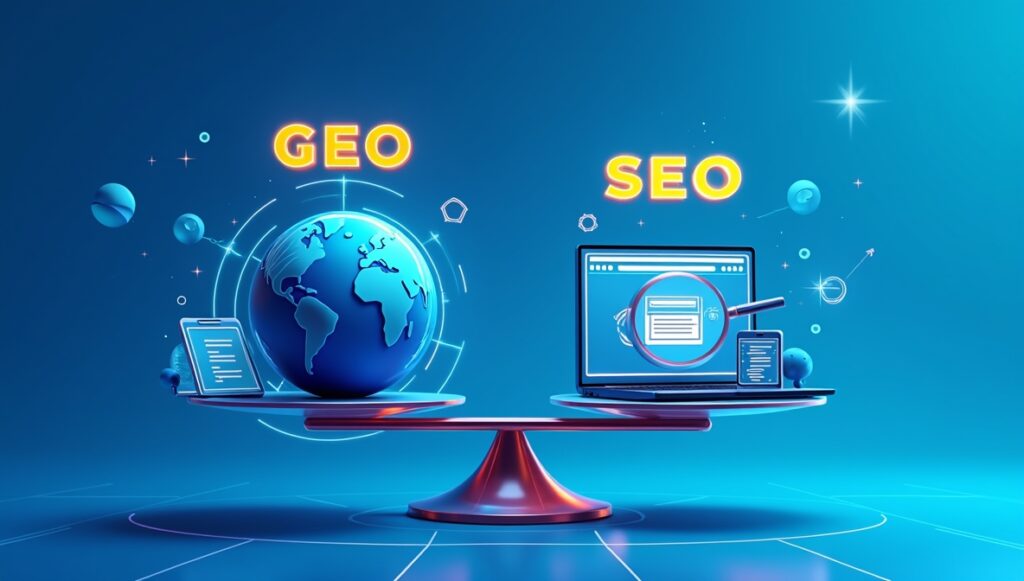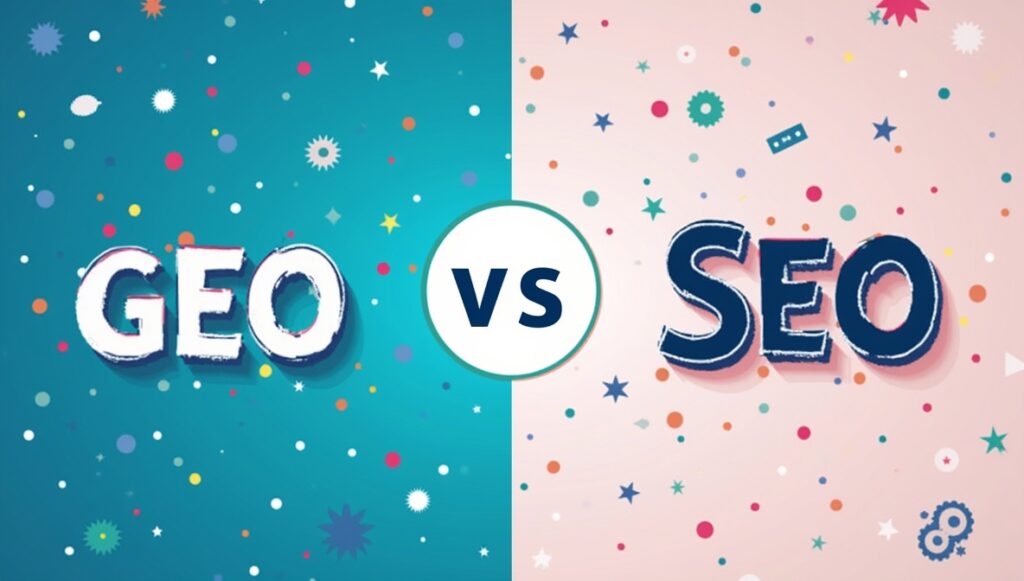
As the digital marketing landscape rapidly evolves, staying ahead means understanding not just traditional SEO (Search Engine Optimization) but also the emerging discipline of Generative Engine Optimization (GEO). In this comprehensive 2025 guide, we’ll demystify the “geo vs seo” debate, covering definitions, success strategies, real-world applications, and actionable advice. Whether you’re a business leader or a marketing manager, Dust Digital Marketing Ltd. brings you elite insights to help your brand thrive in both classic and AI-driven search ecosystems.
Table of Contents
- What Is SEO?
- What Is GEO?
- Geo vs SEO: Key Differences
- Why Both Matter (Case Examples)
- Comprehensive Table: GEO vs SEO
- Frequently Asked Questions (Q&A)
- How to Optimize for Both GEO and SEO
- Why Choose Dust Digital Marketing Ltd.?
- Final Thoughts
What Is SEO?
Search Engine Optimization (SEO) is the cornerstone of digital marketing, focusing on enhancing your website’s visibility on search engines like Google, Bing, and Yahoo. It includes:
- Keyword strategy: Integrating target keywords to match what users search for.
- On-page optimization: Structuring content, headlines, metadata, and internal links.
- Technical optimization: Improving site speed, mobile compatibility, and security.
- Content depth: Creating valuable, accurate, and engaging information.
- Link building: Earning authoritative inbound links to boost credibility.
- User experience: Ensuring low bounce rates and high engagement.
Goal: Achieve high rankings in organic search results to drive relevant, high-converting traffic.
What Is GEO?

Generative Engine Optimization (GEO) is an emerging field tailored for AI-driven search engines and large language models (LLMs) like ChatGPT, Google SGE, or Bing Copilot. Rather than focusing solely on search engine algorithms, GEO prepares your content to be extracted and cited directly in AI-generated answers and knowledge panels.
- Structured, extractable content: Content is clear, fact-based, and easily turnable into direct answers.
- Authority signals: Focus on expertise, experience, author transparency, and original data.
- FAQ and tables: Readily accessible, well-structured answers that LLMs can reliably ingest.
- Up-to-date information: Frequent content refresh to reflect the dynamic nature of AI training.
Goal: Maximize the chance your brand’s information appears in AI-generated summaries, voice assistants, or instant answers.
Geo vs SEO: Key Differences
| Feature | GEO | SEO |
|---|---|---|
| Primary Platform | AI-based search (ChatGPT, SGE, etc.) | Traditional search engines (Google, Bing) |
| Discovery Mechanism | LLM crawling, knowledge extraction | Web crawling, index ranking |
| Ranking Signals | Clarity, structure, E-E-A-T, freshness | Keywords, links, on-page/tech signals |
| Visibility Outcome | Featured in AI answers, summaries | High organic rankings, click-through |
| Content Format | Tables, FAQs, bullet lists, direct facts | In-depth articles, pillar posts, multimedia |
| Strategic Focus | Extractable, unambiguous data | Rich stories, engagement, long-tail search |
Note: E-E-A-T = Experience, Expertise, Authoritativeness, Trustworthiness.
Why Both Matter (Case Examples)
- Traditional SEO gets your site to the top of search engine results, still delivering the bulk of all website traffic in 2025.
- GEO ensures your brand or message appears when users query AI-powered assistants for quick answers, recommendations, or voice searches. As LLMs further integrate with browsing and shopping, being cited or recommended directly in the answer is becoming a major source of brand exposure.
Example:
A Hong Kong coffee brand optimizes its website for “best artisan coffee in Hong Kong” (SEO). Simultaneously, it builds a table of brewing guides and FAQ about local coffee culture, formatted for LLM extraction (GEO). As a result, it ranks #1 on Google and gets cited by ChatGPT when users ask, “Where can I find artisan coffee in Hong Kong?”
Comprehensive Table: GEO vs SEO
| Aspect | GEO | SEO |
|---|---|---|
| Platform Focus | AI models, voice search, instant answers | Google, Bing, Yahoo SERP |
| User Experience | Quick facts, direct answers | Multiple results to click, explore |
| Content Structure | Clear tables, FAQs, structured data | Keyword-rich, in-depth, editorial |
| Authority Building | Cited expert, published data, schema.org | Backlinks, domain authority, reviews |
| Cost/Investment | Content structuring, factual maintenance | Content depth, technical & link-building |
| Measurement | AI answer shares, brand mention frequency | Organic traffic, ranking, conversions |
| Key Performance Metric | Times cited in LLM answers, voice mentions | High ranking positions, web traffic |
Q&A: geo vs seo in 2025
Q1: Will GEO replace SEO in the near future?
A: No. AI-powered search and traditional search engines continue to coexist, catering to different user intents. GEO and SEO should be integrated for maximum digital reach.
Q2: How can I make my site GEO-friendly without hurting my SEO?
A: Create clear tables, FAQs, and summarize complex ideas at the top of articles. These formats suit both AI extraction and feature-rich SEO snippets.
Q3: Are backlinks and traditional SEO signals still important in a GEO world?
A: Yes. Backlinks and authority remain critical for classic search. GEO adds a new layer—instead of replacing SEO, it enhances your visibility in AI search experiences.
Q4: How do I measure GEO effectiveness?
A: Track AI citation frequency, appearance in chat results, and branded mentions. Tools for LLM search monitoring are emerging; integrate with social listening to spot when your content is cited or summarized by AI assistants.
Q5: What are the biggest mistakes brands make with GEO or SEO in 2025?
A: Over-optimization for one channel (e.g., stuffing keywords or ignoring extractable summaries). The key is balance: optimize for both comprehensive answers and AI-ready clarity.
How to Optimize for Both GEO and SEO
- Content Modularization:
Structure articles with clear, extractable answers, using H2/H3 headings for common questions. - Leverage Tables and Lists:
Summarize key information in tables. Example: Compare pricing, features, or tips side-by-side for both human readers and AI bots. - Boost Author Experience and Authority:
Feature expert contributors, cite references, and regularly update your “About” and contact pages. - Use Schema Markup:
Apply schema.org tags to signal data types to both search engines and AI crawlers. - Monitor Emerging AI Search Tools:
Stay updated on ChatGPT plugins, Google SGE, and other voice/AIOps interfaces. - Maintain SEO Best Practices:
Keep refining titles, meta descriptions, alt tags, internal linking, and site performance for human organic users.
Why Choose Dust Digital Marketing Ltd.?
At Dust Digital Marketing Ltd., our Hong Kong-based team combines deep local expertise with global reach. We specialize in both next-generation GEO and proven SEO strategies to secure top placement—whether it’s in traditional search rankings or cutting-edge AI answers.dusthk
- Dual-strategy experts: Proven results optimizing for Google and AI-driven search
- Content excellence: Structured, extractable content designed for both people and algorithms
- Data-driven: Continuous monitoring of AI search trends and SEO analytics
- Full-spectrum solutions: From website audits and link-building to schema and voice search integration
Ready to future-proof your digital marketing? Partner with Dust Digital Marketing Ltd. and ensure your business is #1—wherever your customers search.
Final Thoughts

In 2025, the “geo vs seo” question isn’t about picking one over the other, but building a unified strategy. By mastering both, brands unlock the highest visibility in an era where AI-generated answers and search rankings shape every customer journey.
Want to transform your SEO and GEO strategy? Visit https://dusthk.com and discover how we can help you lead in both worlds.

